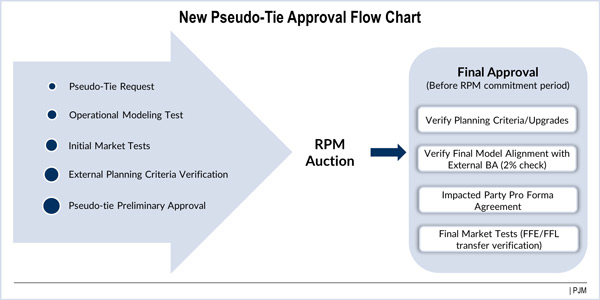By Rory D. Sweeney
WILMINGTON, Del. — PJM and its stakeholders last week found themselves at odds for the second month in a row over requirements for external generators, as members insisted on more time to consider the RTO’s pro forma pseudo-tie agreement.
The stakeholders’ decision to delay a vote came at Thursday’s Markets and Reliability Committee meeting. Later, in the Members Committee meeting, the RTO announced that the Board of Managers will unilaterally file a contentious pseudo-tie rule that members rejected at the January MRC meeting.
Stakeholders had voted to apply stricter requirements to new pseudo-ties but declined to apply them to existing pseudo-tied units, as PJM requested. The lack of endorsement meant that PJM can’t file its proposal under Section 206 of the Federal Power Act and will file instead under Section 205. (See “PJM Uncomfortable with Separate Pseudo-Tie Rules,” PJM Markets and Reliability and Members Committees Briefs.)
“PJM management’s fairly strong recommendation to the board was to file both [new and existing] as 205,” said Senior Vice President of Operations and Markets Stu Bresler. “I can tell you that the board is sensitive to adhering to the stakeholder process,” Bresler said. He said PJM plans to file with FERC by March 10.
PJM Public Power Coalition’s Carl Johnson commended the RTO on its openness throughout the process but said the proposal created an unreasonable lack of certainty on whether units will be approved.
American Municipal Power’s Ed Tatum said the proposal could have been revised enough to find common ground between PJM’s desire for stricter standards and stakeholders’ concerns.
“It is a bit unfortunate,” he said. “We could have prevented what will likely be many protests. I feel like we could have gotten this right.”
Members Balk at Pro Forma Agreement
Earlier in the meeting, stakeholders stood fast, insisting on additional time to improve the language of the pro forma pseudo-tie agreement despite concerns that further delay could create confusion during an emergency. Members said that FERC’s lack of a quorum meant there was no pressing need to rush the agreement for a commission filing.
“It’s not just delay for delay’s sake,” Johnson said. The existing document is better than previous versions, he said, but additional improvements could be made.
The pro forma agreement is intended to ensure uniformity in the rules for future pseudo-tie generators. But PJM said it has had trouble obtaining agreement with other balancing authorities on pseudo-tie terms, and variations in wording have created confusion about correct operating procedures. PJM staff said they have discussed it with neighboring transmission operators, including Duke Energy, SPP, MISO and East Kentucky Power Cooperative.
The agreement will address congestion management with entities where PJM doesn’t already have such an agreement, ensure impacts of the pseudo-tied unit are recognized in market flows, require firm status for transfers and require use of NERC’s interchange distribution calculator redispatch mechanism.
“What I’m finding is that even in discussions with other [balancing authorities] … not one of them has a problem with the agreement per se. They just have a concern with pseudo-ties. MISO feels the agreement is redundant. … The vast majority of what’s in there is not redundant,” PJM Associate General Counsel Jacqui Hugee said.
Bruce Bleiweis of DC Energy said he recently attended a NYISO meeting where stakeholders didn’t know what a pseudo-tie was, so it’s unlikely that the education process would be expedient there.
PJM: Let FERC Sort it Out
Several stakeholders asked that any disputes be resolved before submitting the agreement to FERC, but PJM General Counsel Vince Duane urged the opposite.
“After trying as best we can to get substantive input from our neighbors, [the idea is to] file with the commission, and that will allow everyone to come in and file their opinions,” he said. “We need to get a forum in place, and I’m not confident the stakeholder processes outside of PJM are going to provide that forum any time soon.”
While the new process might take longer than before to secure necessary approvals, PJM expects it will give applicants more certainty about expectations for pseudo-ties. The agreement would also expand the RTO’s existing reimbursement agreement, which would be codified in the Tariff. If the parties can’t come to terms on the agreement, PJM would file the unexecuted agreement for FERC review.



